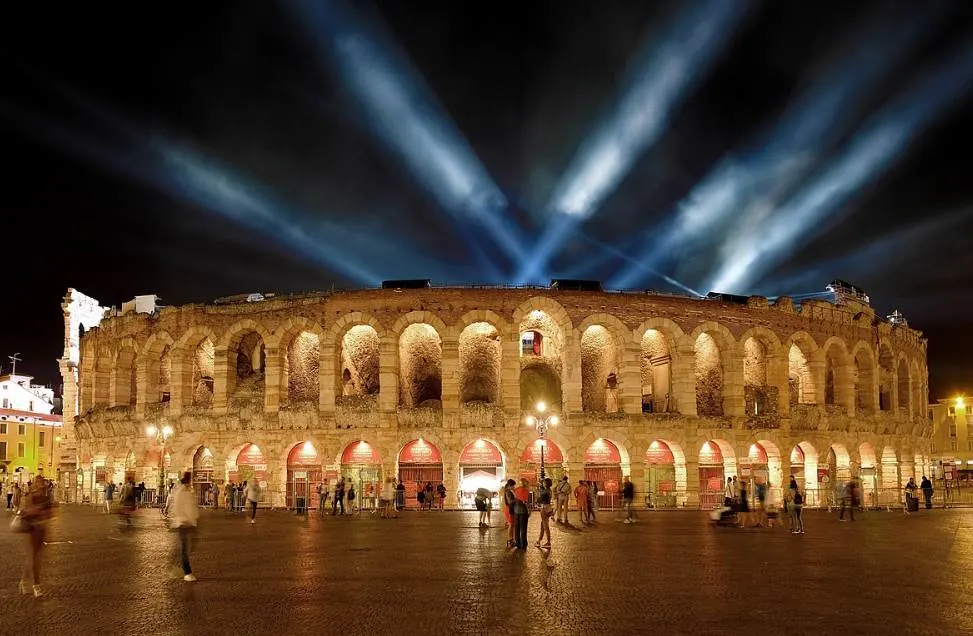The most famous Roman Amphitheater ever constructed is the Colosseum in Rome, an ancient entertainment venue that could seat up to 50,000 people.
These structures were constructed all around the Roman Empire in various sizes based on the number of people that lived in that particular city.
Many of these arenas still stand today and are even used for modern-day entertainment. Yes, the days of gladiators fighting to the death are permanently over.
Let’s take a closer look at some of the most interesting facts about the Verona Arena, one of the ancient venues that are still used extensively today.
1. It’s located on the largest square of a city in northern Italy
The Verona Arena is one of the most fascinating landmarks in the Italian city of the same name in the Veneto region of northeastern Italy.
Verona is one of the largest cities in the region. Over 700,000 people live in its metropolitan area. It’s filled with historic landmarks, including several ancient structures.
The arena is located at the Piazza Bra, an important square in the city commonly referred to as “Bra.” It’s lined with cafes and restaurants which makes it an enjoyable place to hang out.
This square is located right in the heart of the city, an area referred to as the “Città Antica.”

2. The arena was constructed in the 1st century A.D.
Ths history of Verona remains a mystery until it became a Roman Colony in 89 B.C. This small settlement quickly grew and it became a city or “municipium” in 49 B.C.

The Ponte Prieta, a bridge completed in 100 B.C., surely helped to make the city grow in importance and as the population grew, entertainment venues were constructed.
The Verona Arena was completed in 30 A.D. during the reign of Roman Emperor Tiberius (42 B.C.-37 A.D.), the second emperor after Augustus (63 B.C.-14 A.D.).
Yes, this means that this incredible Roman amphitheater is about the celebrate its 2,000th anniversary, a baffling figure!

3. It could seat over half the number of spectators as the Colosseum
The arena was so big that the engineers decided to build it outside of the city walls in ancient times. It also predates the Colosseum by nearly half a century.
The estimated capacity of the arena upon completion was about 30,000 spectators. That’s over half of the number that could sit inside the Colosseum.
This number still makes it the third-largest amphitheater in Italy after the Colosseum in Rome and the ruined amphitheater of Capua.
Granted, ancient spectators were squeezed into the arena just like sardines into a can. Because a stage has been constructed and there is more space to sit in the stands, the current capacity is 22,200 spectators (which is still a lot).

4. The exterior wall was once clad in white and pink limestone
Verona is a UNESCO World Heritage site because of the large number of historic buildings that are located inside the city center.
Although there are still several ancient monuments standing, many were destroyed during a devastating earthquake that took place in the year 1177.
Many ancient buildings were damaged and the stones were used to rebuild the city in the Romanesque architectural style.
The arena was constructed in such a robust manner that it withstood this calamity except for the outer ring of the building. This was once clad in white and pink limestone similar to Egyptian pyramids.
Just like the other destroyed structures, these stones were used to construct other buildings in Verona.

5. The arena is still used for concerts and opera performances today
The admiration for ancient Roman structures got into full swing during the Renaissance.
The Pantheon in Rome was referred to as “not of human design” by Michelangelo and the Verona Arena was admired for the way it was constructed as well.
Some attempts were made to restore the venue in the 15th century but a full-blown restoration project wasn’t launched until the 19th century.
This transformed the ancient arena into an arena that could still be used as an entertainment venue in modern times.
The first operatic performances were held here during the 1850s and today, the Roman amphitheater is still an important opera venue and is used for concerts as well.

More interesting facts about the Verona Arena
6. The Verona Arena is an enormous structure that covers a vast space at the Piazza Bra. It has an oval shape and dimensions of 140 x 110 meters (459 x 360 feet).
7. Medieval visitors to Verona have always been baffled by the amazing ancient structure. One of them referred to the arena as a “labyrinth that doesn’t have an entrance or exit.”

8. The white and pink limestone that once decorated the structure’s exterior was quarried in Valpolicella. This is an important wine region in the province of Verona just east of Lake Garda.
9. At least 4 operatic productions are performed between the months of June and August. An estimated 500,000 visitors attend these performances every year.

10. Some of the most famous artists in history have held concerts at the arena. Pink Floyd, Bruce Springsteen, Whitney Houston, and Jamiroquai are just a few artists who performed here.
11. It has hosted a podium for the winners of the cycling race called Giro d’Italia several times. This happened in the years 1981, 1984, 2010, 2019, and 2022. The same ceremony of the Tour de France is held at the Champs Élysées in Paris.

12. The first Arena di Verona Festival was held at the arena in 1913 to commemorate the 100th birth anniversary of famous Italian composer Giuseppe Verdi (1813-1901). This festival is still held every year in recent times.

